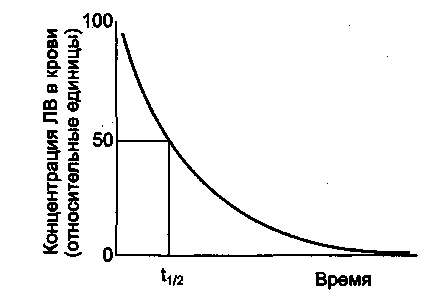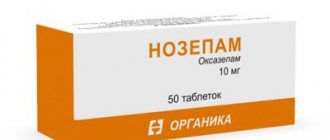Phenazepam is a tranquilizer from the group of benzodiazepines. It is most effective in comparison with other medications in this group. Phenazepam is considered the most severe tranquilizer.
A large number of indications for use are limited to the same list of contraindications and side effects. Psychiatrists, neurologists and narcologists prescribe this drug for a long term. Sometimes patients are forced to take phenazepam for months because other drugs do not cope with the symptoms of their diseases.
The mechanism of action of benzodiazepine tranquilizers is associated with the activation of inhibitory neurons in the brain. This explains the sedative and anticonvulsant effect. With prolonged use, brain cells get used to functioning against the background of the constant presence of a tranquilizer in the blood. When abruptly stopping the use of phenazepam, a withdrawal syndrome develops associated with a rapid decrease in the concentration of the substance in the body.
Phenazepam elimination duration
If the patient stops taking the medicine, the concentration of the latter in the body decreases gradually. There is a concept - the half-life of a drug. This is the time during which the concentration of a substance in the blood decreases by 2 times. For phenazepam, the minimum is 6 hours, the maximum is 18.

This means that when using 2 mg of phenazepam every other day, a concentration of 0.125 mg can be expected. When taking 4 mg every other day it will be approximately 0.25 mg. The onset of withdrawal syndrome occurs when only traces of the drug remain in the blood, and most of it is eliminated. The longer the patient took the drug, the greater the likelihood of developing withdrawal syndrome. The time of onset of its symptoms depends on how much of the drug the patient usually drinks. If the dosage is large, the drug is eliminated for a long time, but more severe symptoms develop.
How long does Phenazepam stay in the body?
After oral administration, the active substance of the product is quickly absorbed by the mucous membrane of the digestive tract. Its maximum concentration in the blood is recorded after 1-2 hours.
Phenazepam is processed in the liver, where it breaks down into active metabolites. They are excreted mainly by the kidneys, and to a small extent by the intestines.

Several factors influence how quickly the drug Phenazepam is eliminated from the body:
- patient’s age – the older the person, the slower the process;
- the patient’s health condition - problems with the kidneys, liver, slow metabolism can significantly extend the half-life of the component;
- how many days the drug was used - with a single dose, the average cleansing of the body is 48-60 hours. After a course of therapy, it takes about 7-8 days to remove Phenazepam;
- the fact of parallel use of medications - some medications increase the half-life of the active substance, while others, on the contrary, accelerate its metabolism;
- individual characteristics of the body - despite the availability of official data on the pharmacokinetics of the drug Phenazepam, the situation may differ in each specific case.
Taking into account all of the above points, scientists stated that on average it takes 70-72 hours to cleanse tissues of the breakdown products of the drug “Phenazepam”, if we are not talking about a course of therapy. By this point, about 97% of metabolites are removed from the tissues. Practice shows that there are several ways to speed up the process.
Manifestations of withdrawal syndrome
Phenazepam is addictive because brain cells begin to function over time to adapt to it. Their activity, modified by the presence of the drug, causes a withdrawal syndrome when the drug is abruptly stopped.
The fact is that during administration, neurons responsible for excitation of the central nervous system are inhibited by inhibitory neurons. The first try to compensate for the balance and increase their activity. Inhibitory neurons cannot cope, which dictates the need to increase the dosage of the medication. More dosage means more inhibition. The more pronounced the inhibition, the more the excitatory part of the brain is activated.
Phenazepam inhibits the excitation of the central nervous system, therefore, when using large doses, a sedative effect is achieved for a long time. When you stop taking it, the concentration of phenazepam drops, the neurons are disinhibited. In this case, nothing further prevents the excitatory cells from expressing their activity, stimulated by the use of the drug. This leads to the development of the following symptoms:
- Excitement, aggression, agitation;
- Resumption of hallucinations, delusions;
- Insomnia;
- Convulsions, tremors;
- Spasmodic pain in the abdomen, difficulty swallowing;
- Spasmodic pain in the muscles of the whole body;
- Nausea, vomiting, increased sweating;
- Increased sensitivity to light and sound, numbness, “crawling” feeling.
All these manifestations are due to the fact that brain neurons send a large number of impulses to each other and to muscle tissue cells.
Withdrawal syndrome lasts on average from a week to a month.
Treatment options
Dependence on Phenazepam is the same as drug addiction.
It may appear after regular use of the drug, even in therapeutic doses for a short time. Addiction is especially likely in patients who abuse alcohol or drugs. Also at risk are patients with severe personality disorders. Benzodiazepines should not be stopped suddenly after regular use. Over several weeks, the daily dose of the drug is gradually reduced. The time it takes to stop the drug can vary from 4 weeks to a year or more. It is impossible to predict with absolute certainty the development of dependence on benzodiazepines, but there are risk factors that can provoke it:
- high dosage;
- regular continuous use;
- use of benzodiazepines with a short half-life;
- use by patients addicted to drugs or alcohol and with developed tolerance to Phenazepam substances.
The mechanism of benzodiazepine dependence is unclear. One possible cause is a relative deficiency in the functional activity of gamma-aminobutyric acid (GABA), resulting from downregulation of GABA receptors.
Withdrawal symptoms
Symptoms include anxiety, depression, difficulty concentrating, insomnia, headache, dizziness, tinnitus, loss of appetite, tremors, sweating, irritability, and withdrawal symptoms. As well as perceptual disturbances such as hypersensitivity to physical, visual and auditory stimuli, taste abnormalities, nausea, vomiting, abdominal cramps, palpitations, mild systolic hypertension, tachycardia and orthostatic hypotension.
Poor sleep with nightmares or increased sleepiness may persist for several weeks after stopping benzodiazepines. Abrupt refusal to take it can lead to coma and death.

Hallucinations and nightmares may accompany drug withdrawal
Drug withdrawal regimen
In order to prevent the development of a pathological syndrome, there are different methods for correctly stopping phenazepam. The simplest and most effective way is to gradually reduce the dosage. Experts recommend reducing the dose of the drug by 10% of the original every two weeks. Thus, you can completely stop taking the drug 5 months after the start of gradual withdrawal.
There are also accelerated regimens that include the prescription of drugs that can “cover up” the absence of phenazepam. These regimens are selected by the attending physician, depending on the pathology for which phenazepam was prescribed.
The main signs of an overdose of phenazepam.

- The patient falls into a stopper . The pupils noticeably narrow, attacks of nausea and vomiting appear, and muscle tone decreases.
- Extremely high salivation.
- Further, with an overdose of phenazepam, a person loses consciousness and develops respiratory failure. At this stage, it is necessary to take urgent measures to save the phenazepam addict.
- Urinary retention is acute , but in exceptional cases there is involuntary urination.
- Blood pressure drops quickly.

At even the slightest of such manifestations, it is necessary to seek drug treatment help. A modern drug treatment center in St. Petersburg provides, as one of its services, emergency drug treatment assistance around the clock. Our specialists can carry out all the necessary procedures for returning the patient to normal well-being both in a hospital setting and at the patient’s home. Call us now - don’t expect the problem to be solved by itself - it’s impossible. Timely use of qualified assistance from narcologists is the key to success in this difficult matter.
Reviews
Andrey K .: “I took phenazepam for three months, after which I decided to stop taking it on my own. I knew that I shouldn’t drink this drug or alcohol, and there were holidays ahead. After stopping the use of phenazepam, I began to experience severe muscle pain, nausea, and aggressiveness. I think it's like a drug addict going through withdrawal. I had to see a doctor and resume taking it.”
Tatyana M .: “I stop taking phenazepam gradually, as the doctor advised. I drank this substance for a very long time, almost six months. Now you can switch to other drugs, but the doctor said that you can’t suddenly quit phenazepam. I used to take 4 mg, but now I’ve reached 3.2 mg. The only thing I don’t like is that it’s inconvenient to divide the tablet into parts.”
Doctor's review: “Fenazepam has many unpleasant features. One of them is the deterioration of patients’ condition when abruptly stopping its use. As a rule, symptoms develop when you stop using the drug without authorization. Such patients present to the clinic with symptoms exceeding those for which they were initially treated. Therapy has to start all over again, one might say, from scratch.”
Content
Test for Phenazepam
Determination of phenazepam in biological fluids is necessary primarily in cases of severe poisoning.
Symptoms of overdose are non-specific, so tests are immediately carried out for other psychoactive substances with a similar effect. In the acute phase, blood is examined, but urine is considered a more convenient material. In forensic practice, the result must be confirmed using several methods. The most effective are the following:
- GC-MS - gas chromatographic analysis with mass spectrometry.
- HPLC-MS/MS is high-performance liquid chromatography with tandem mass spectrometric detection.
Rapid tests work on the principle of the immunochromatographic method. The strip is used immediately before the test strictly according to the instructions. There are many manufacturers of quick tests (“Narcoscreen”, “CreativeMP”, “Narcochek”), so differences are possible.
The rate of metabolism of psychoactive substances is influenced by individual characteristics, excess weight, the size of the dose taken, as well as the length of abuse.
Blood is suitable for analysis for only 12-18 (24) hours. Phenazepam remains in the urine for up to 4 days.
External signs of drug intoxication
The effect of Phenazepam resembles a state of alcohol intoxication. You can find out that a person has taken a large dose of a tranquilizer by the following signs:
- lack of coordination, unsteady gait;
- talkativeness, an inexplicable desire to communicate (especially noticeable if a person does not like to communicate in a sober state);
- slurred, confused speech;
- pale, bluish skin;
- dilated pupils, poorly responsive to changes in lighting;
- whitish coating on the tongue and entire oral cavity;
- dry eyes and other mucous membranes;
- loss of appetite.
A person can remain in this state for about a day. After the drug wears off, the person feels drowsiness, apathy, and weakness of the limbs (“wobbly” legs).
Just 3-4 weeks of regular use of Phenazepam as a drug is enough to form an addiction to the drug. In the future, the previous dose will no longer cause euphoria, and the person will have to use more and more medication to avoid withdrawal symptoms and get a “high.” Gradually, the drug becomes the only meaning of the addict’s life, destroying his body and psyche.
Effects of phenazepam on the body
Being a sedative, Phenazepam has a complex effect: sedative, anxiolytic, anticonvulsant and hypnotic. By influencing the limbic system of the brain, it reduces anxiety, fear, nervousness, anxiety, and also relaxes most of the muscles of the body, stops cramps and simplifies the process of falling asleep.
The medicine can stay in the blood for more than a day, although the effect of taking it lasts in the range of 6-8 hours. Residual doses can be detected by chemical toxicological analysis of blood and urine, but since this type of research can be expensive, this method is rarely used.
You can neutralize Phenazepam by drinking a large amount of water, for a better mineral effect, in order to quickly remove the active substances.
The above-mentioned consumption of a large volume of liquid will help in how to remove Phenazepam from the body; in addition, you can use diuretics. It is advisable not to take the latter before bed to avoid frequent trips to the restroom at night.
Available analogues
Numerous side effects with long-term use of Phenazepam force patients to select other medications. The following drugs are in demand analogues of the drug:
- "Phenorelaxan".
- "Fesipam".
- "Fenzitat."
- "Fezanef".
- "Elzepam".
- "Tranquesipam."
"Phenazepam" belongs to the category of potent tranquilizers of the benzodiazepine group, which have a pronounced sedative, hypnotic, and anxiolytic effect. Due to the specific effect of the drug on the nervous system, a high degree of effectiveness is achieved in the treatment of many neurological and psychopathic pathologies, insomnia.
That is why the sale of the drug from pharmacies without a prescription is strictly prohibited. "Phenazepam" can be taken only as prescribed by a doctor, observing the dosage. Otherwise, the patient may face unpredictable consequences that will negatively affect the functioning of the entire body.
Contraindications
It is strictly forbidden to take the drug with alcoholic beverages. The action of Phenazepam with alcohol can lead to shock. In addition, there are a number of other strict restrictions:
- acute respiratory failure;
- angle-closure glaucoma (including a tendency to it);
- coma;
- state of shock;
- myasthenia gravis;
- hypersensitivity to components;
- acute poisoning with drugs, sleeping pills, alcohol;
- childhood and adolescence (action and effect unknown);
- state of severe depression.
Pregnant and lactating women are strongly advised not to take Phenazepam. The effect on the child’s body can be overwhelming and depressing, as a result of which newborns are born lethargic (with poor breathing, appetite, inactive), often with congenital pathologies of the nervous system. It is especially dangerous to use the medicine in the first trimester of pregnancy.
Diuretic infusion of nettle
Ingredients: dry nettle leaves – 50 g, water – 1.5-2 l
This recipe is very simple. We simply pour boiling water over the nettles and let it all brew for about 2 hours. We drink the infusion evenly and remove Phenazepam from the body evenly.
The only danger of these products that remove urine is that along with bad substances, they also remove good substances from the body - vitamins, proteins, minerals.
Therefore, you need to pay attention to your diet during the period of cleansing the body, removing Phenazepam prematurely. Make sure you have enough proteins and vitamins in your diet.
To restore the body after withdrawal from Phenazepam, it is recommended to take special vitamins.
The drug phenazepam and its dose
This medication is highly popular in the prevention and treatment of a large number of diseases. The principle of its effect on the human body is to slow down brain processes. For this reason, experts prescribe this drug in the following cases:

You can use phenazepam if the patient develops an anxious, irritable or aggressive emotional state.- Can be used as tablets when the patient has vegetative-vascular dystonia.
- If a person feels dizziness and pain in the head, then it is also worth using this remedy.
- Some types of epilepsy or regular seizures are often treated with Phenazepam.
- In surgical practice, it is used as a means of coping well with pain, or when introducing a person into a state of anesthesia.
It is worth noting that you should take phenazepam very carefully , as it is possible to develop a certain addiction, which will be no different from the disease of drug addicts.
Employees of medical institutions are careful when prescribing this drug, its dosage, and the course of taking the drug, since all these criteria can negatively affect the human body. Along with all this, treating specialists categorically prohibit drinking the drug together with alcoholic beverages, because such a combination can cause a negative reaction in the patient’s body. The drug should only be used for a hangover. There have been cases of poisoning due to the drug











